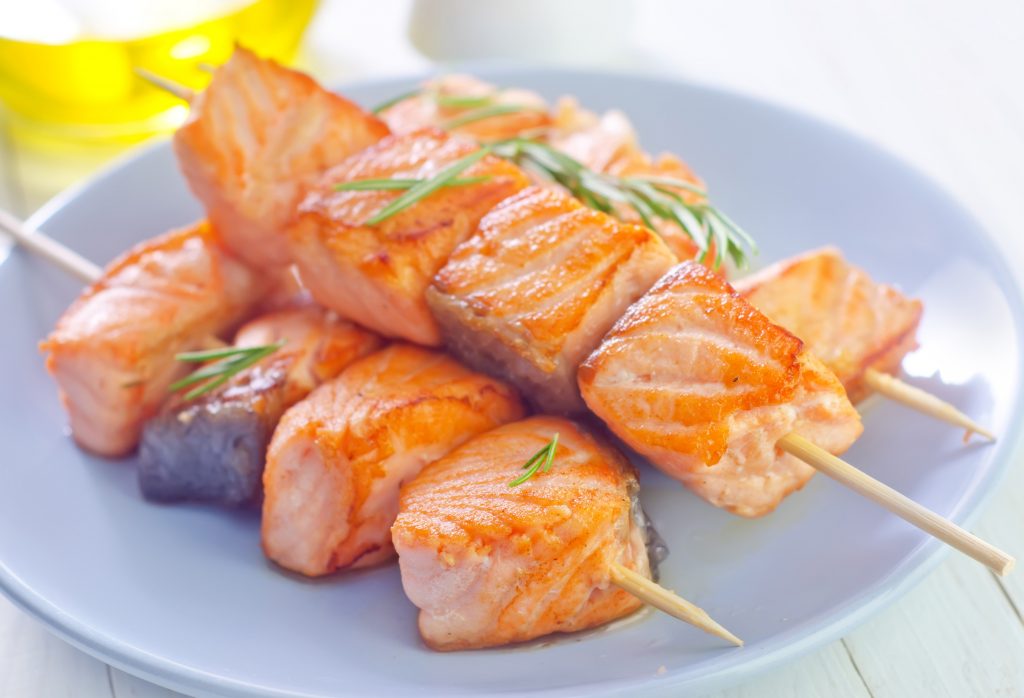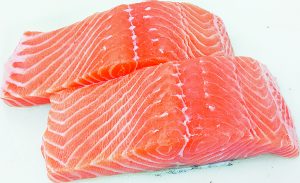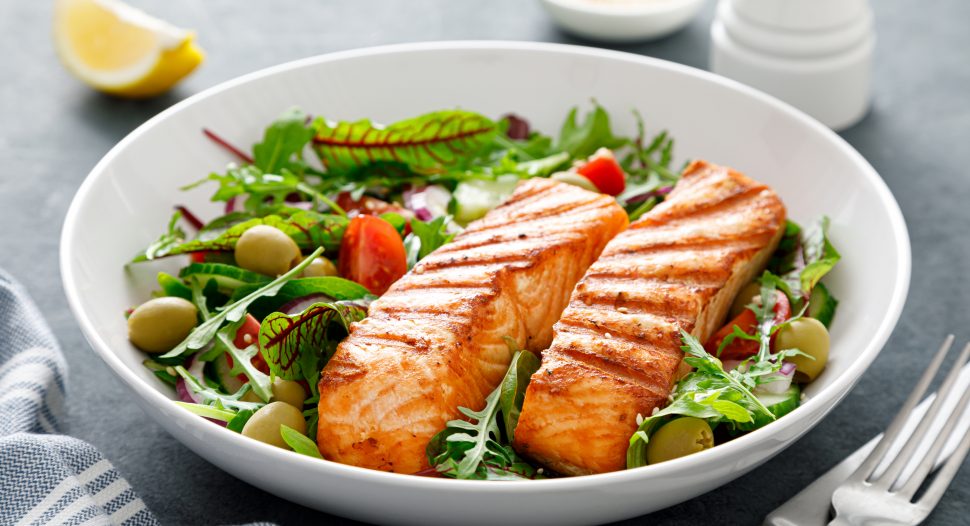It’s delicious any way you decide to cook it. What is it? Salmon!
Salmon is tasty and versatile with an undeniable popularity. It’s also very nutritious — regular consumption can benefit your health by making up for most vitamin and mineral deficiencies¹ easily.
Get ready to love this superfood even more with the 5 impressive health benefits of salmon explained!
1. Bolsters the brain and mental health
Salmon is rich in two long-chain omega-3 fatty acids: eicosapentaenoic acid (EPA) and docosahexaenoic acid (DHA). EPA and DHA are unsaturated fats that are considered “essential” because your body cannot produce them naturally and must be obtained through a balanced diet². They have both been found to help reduce depressive symptoms, as well as protect against age-related brain diseases!
Fun fact: The eye of a salmon tends to lean more on the flavourful side. If you’re feeling adventurous, try grilling the head with some salt to eat alone, or simmer with other ingredients for a light, yet nourishing soup! Just remember to remove the salmon head before serving if you prefer that.
Recipes to try: Salt Grilled Salmon Head & Collar
Salmon Head Soup
2. Strengthens the skin
Some people like to remove the skin before cooking a salmon fillet, but here’s a reason not to — the skin actually contains the highest concentration of omega-3 fatty acids³. Yup, that’s one of the essential omega-3 fatty acids we talked about earlier! Besides bolstering the brain and mental health, omega-3 fatty acids may also support the production of collagen, the most abundant protein in the body⁴. Collagen from salmon skin can help to strengthen your skin, hair and nails to keep you feeling and looking young all the time!
Love your salmon and you cannot lie? Try buying a whole salmon at our stores instead! It’s a more budget-friendly option as well. Read on for a convincing case to buy and cook up a whole salmon.
Simply ask your friendly fresh expert at the fish bay to remove the salmon skin properly for you and keep it aside in a separate bag! You can also have a whole salmon cleaned and perfectly pre-portioned into different parts in-store! Watch and learn more about it:

Norwegian Whole Salmon
3. Protects against inflammation

A predominantly marine-sourced carotenoid, astaxanthin is an antioxidant with anti-inflammatory properties⁵. The bright orange-red or pinkish colour of salmon is actually due to the high levels of astaxanthin to protect its flesh from sun damage⁶.
This means that the protective benefits of salmon can be great for your skin, too! In fact, a comparison study found that astaxanthin displayed the highest antioxidant activity against free radicals⁷. Feel and look younger every day with salmon!
Recipe to try: Salmon Belly Skewers
4. Energises the body
Salmon contains nearly the whole spectrum of B vitamins — B3, B5, B7, B6, B9, B12, and so on all in one source⁸. B vitamins play a pivotal role in maintaining the balance between all bodily functions. For example, vitamin B3 (niacin) is needed to transform the food you eat into the energy your body needs so your cells can keep functioning properly.
Glutamine, an amino acid, is also found in salmon. This building block of protein helps in energy production and its sustained release throughout the day⁹.

Norwegian Salmon Fillet
Norwegian Whole Salmon and Norwegian Salmon Fillet
are both available at your nearest FairPrice store here
5. Supports thyroid function
Selenium and iodine are trace minerals present in salmon that are crucial for a healthy thyroid. The thyroid is a small gland that secretes hormones to regulate your body’s metabolic processes; without a steady supply of both trace minerals, the thyroid will be unable to function properly.
Individually, these are how both trace minerals support thyroid function:
Selenium: Boosts immunity against environmental pollutants
Iodine: Bolsters metabolism for cell growth¹⁰
This may result in an underactive thyroid¹¹ with fatigue, weight gain, depression and muscle aches as common symptoms.
Tips for cooking salmon
If you want to cook salmon, it must be heated to an internal temperature of 63°C to effectively reduce the presence of most food-borne bacteria. Marination can help to enhance its flavour during the cooking process as well!
| Fun fact: Salmon is the star ingredient in many traditional dishes across cultures. Sashimi is a Japanese dish of thinly sliced raw salmon, tuna or even swordfish. On the other hand, Norwegians have gravlax — an appetiser consisting of cured salmon in salt, sugar, and dill¹²! |
Serving recommendation: Half of your Healthy Plate is for veggies and fruits and a quarter for wholegrains. That leaves the last quarter. The remaining 25 per cent is for protein and calcium-rich foods¹³.
At least twice a week, choose salmon as your source of protein and healthy fats. A serving size is 100 to 250g of salmon, depending on your body size and nutritional needs! 150g of salmon is one serving as a general rule of thumb.
We hope that this article has convinced you to give salmon a try, if you haven’t already done so! Still not convinced? We’re currently running a Salmon Fair (7 – 13 September 2023) with attractively priced deals!
***
References:
¹ SafeBeat 2021, 12 health benefits of salmon for the heart, brain, and much more, viewed 24 February 2022
² The President and Fellows of Harvard College 2022, Omega-3 fatty acids: an essential contribution, viewed 24 February 2022
³ Watson, K 2017, Can you eat salmon skin?, Healthline, viewed 25 February 2022
(Medically reviewed by Butler, N, R.D., L.D)
⁴ Spritzler, F 2021, 11 impressive health benefits of salmon, Healthline, viewed 24 February 2022
Jackson-Gibson, A 2019, 12 collagen-rich foods to eat for healthy, radiant skin, Good Housekeeping, viewed 25 February 2022
⁵ Aimee Sutliff, Lauren O’Connor, Audrey Hendrick, Minghua Tang, Kevin Quinn, Katrina Doenges, Jamie Westcott, Sarah Borengasser, Richard Reisdorph, Daniel Frank, Dingbo Lin, Wayne Campbell, Nancy Krebs, Nichole Reisdorph, Astaxanthin levels are higher in fresh salmon compared to canned and pouch varieties, Current Developments in Nutrition, Volume 4, Issue Supplement_2, June 2020, Page 128, https://doi.org/10.1093/cdn/nzaa041_032
⁶ Ingenious Beauty 2019, Astaxanthin and salmon, Coltec Laboratories Ltd, viewed 26 February 2022
⁷ Healthline Editorial Team 2018, 7 potential benefits of astaxanthin, Healthline, viewed 26 February 2022
⁸ Girdwain, A 2019, 6 healthy reasons why salmon is a staple of practically every eating plan out there, Well and Good, viewed 1 March 2022
⁹ O’Neill, M 2021, 13 salmon benefits, according to nutritionists, Health, viewed 1 March 2022



